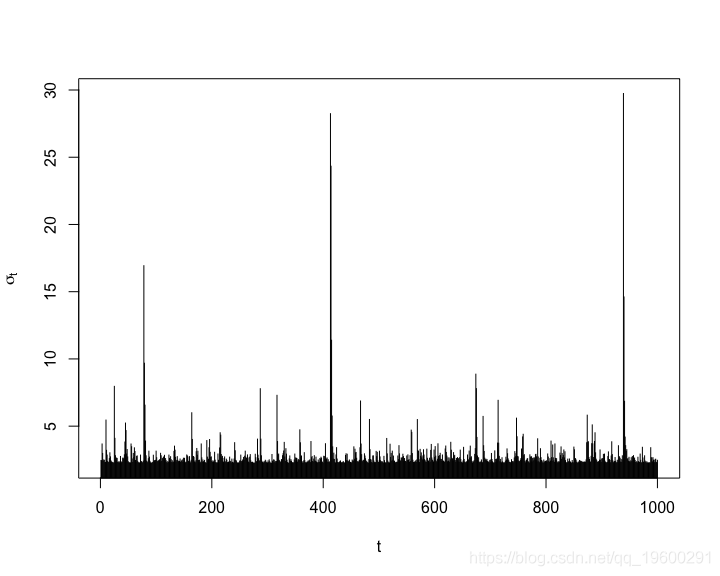版权声明:本文为博主原创文章,未经博主允许不得转载。咨询链接:http://y0.cn/teradat 博文链接: https://blog.csdn.net/qq_19600291/article/details/89921719
本文显示了如何基于潜在的ARMA-GARCH过程(当然也涉及更广泛意义上的QRM)来拟合和预测风险价值(VaR)。
我们考虑使用\(t \)分布式创新的ARMA(1,1)-GARCH(1,1)过程。
模拟一条路径(用于说明目的)。
nu <- 3 # d.o.f. of the standardized distribution of Z_t fixed.p <- list(mu = 0, # our mu (intercept) ar1 = 0.5, # our phi_1 (AR(1) parameter of mu_t) ma1 = 0.3, # our theta_1 (MA(1) parameter of mu_t) omega = 4, # our alpha_0 (intercept) alpha1 = 0.4, # our alpha_1 (GARCH(1) parameter of sigma_t^2) beta1 = 0.2, # our beta_1 (GARCH(1) parameter of sigma_t^2) shape = nu) # d.o.f. nu for standardized t_nu innovations armaOrder <- c(1,1) # ARMA order garchOrder <- c(1,1) # GARCH order varModel <- list(model = "sGARCH", garchOrder = garchOrder) spec <- ugarchspec(varModel, mean.model = list(armaOrder = armaOrder), fixed.pars = fixed.p, distribution.model = "std") # t standardized residuals 作为一个完整性检查,让我们绘制模拟路径,条件标准偏差和残差。
plot(X, type = "l", xlab = "t", ylab = expression(X[t])) plot(sig, type = "h", xlab = "t", ylab = expression(sigma[t])) 
plot(eps, type = "l", xlab = "t", ylab = expression(epsilon[t])) 
2将ARMA-GARCH模型拟合到(模拟)数据
适合ARMA-GARCH流程X(在此处使用正确的已知订单;通常适合不同订单的流程然后决定)。
让我们再考虑一些健全性检查。
## Fit an ARMA(1,1)-GARCH(1,1) model spec <- ugarchspec(varModel, mean.model = list(armaOrder = armaOrder), distribution.model = "std") # without fixed parameters here fit <- ugarchfit(spec, data = X) # fit ## Extract the resulting series mu. <- fitted(fit) # fitted hat{mu}_t (= hat{X}_t) sig. <- sigma(fit) # fitted hat{sigma}_t ## Sanity checks (=> fitted() and sigma() grab out the right quantities) stopifnot(all.equal(as.numeric(mu.), fit@fit$fitted.values), all.equal(as.numeric(sig.), fit@fit$sigma)) 


3计算VaR时间序列
计算VaR估计值。请注意,我们也可以在这里使用基于GPD的估算器。
4 Backtest VaR估计值
让我们回顾一下VaR的估计。
## [1] 10 ## [1] 12 ## [1] "Correct Exceedances" ## [1] "Fail to Reject H0" ## [1] "Correct Exceedances & Independent" ## [1] "Fail to Reject H0" 5基于拟合模型预测VaR
现在预测VaR。
6模拟\((X_t)\)的未来轨迹并计算相应的VaR
模拟路径,估计每个模拟路径的VaR(注意quantile()这里不能使用,因此我们必须手动构建VaR)并计算\(\ mathrm {VaR} _ \ alpha \)的自举置信区间。
7
最后,让我们显示所有结果。

非常感谢您阅读本文,有任何问题请在下面留言!
文章来源: https://blog.csdn.net/qq_19600291/article/details/89921719